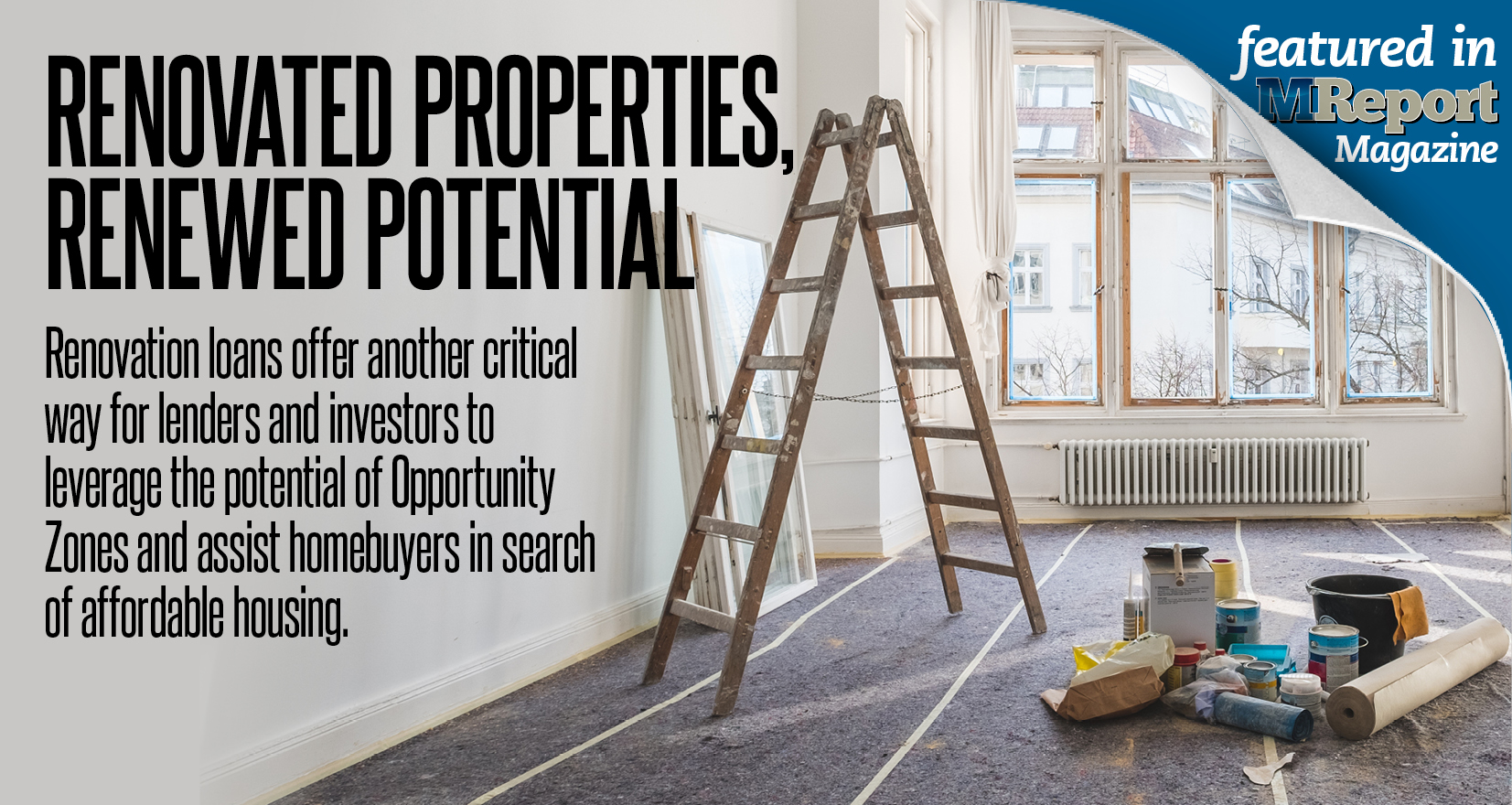
Editor’s note: This feature originally appeared in the January issue of MReport.
Through the 2017 Tax Cuts and Jobs Act, Congress created Opportunity Zones to incentivize investment into undercapitalized communities considered “economically distressed” in exchange for certain tax benefits. Since the IRS designated the first set in April of 2018, Opportunity Zones have grown to cover more than 8,700 census tract areas in all 50 states and the District of Columbia, along with five U.S. territories.
An Opportunity Zone is defined as a low-income census tract area. It may be designated as such under a variety of criteria, such as having a high rate of poverty, median family income that is 80% or less than the median family income designated based on the location, or a rural county considered “high-migration,” which combines elements of median family income and outmigration patterns.
The Basics
Opportunity Zones also present mortgage bankers with the unique opportunity of both increasing their own production volume and assisting in the reinvigoration of economically distressed communities through single-family renovation or rehabilitation lending programs. The most popular of these is the Standard and Limited versions of the FHA 203(k) along with the conventional renovation products from Fannie Mae and Freddie Mac. Fannie offers the HomeStyle Renovation loan while Freddie’s is the CHOICERenovation loan program.
All three programs share many common features, but there are also important and distinct differences. For example, there are different minimum and maximum renovation costs required along with a maximum loan-to-value allowed. However, FHA’s Limited 203(k) program has had some recent enhancements that make it a game changer for properties in Opportunity Zones.
The FHA Limited 203(k) program allows eligible homebuyers to purchase a single-family residence and finance up to $35,000 of allowable improvements into the purchase loan with as little as a 3.5% down payment for approved borrowers. With a 30-year fixed interest rate, the Limited 203(k) is a popular product for prospective homebuyers looking to purchase older homes that need some of the proverbial “TLC” in terms of updates and upgrades. The Limited 203(k) also allows current homeowners to finance up to the $35,000 of repairs on their primary residence, making it a great option for owners looking to take on a remodeling project.
On November 22, HUD Secretary Ben Carson announced enhancements to the Limited 203(k), making it an even better deal for borrowers looking to purchase and rehabilitate or renovate an existing primary residence located within an Opportunity Zone. After announcing incentives for multifamily property owners in May, FHA issued Mortgagee Letter (ML) 2019-18. In a nutshell, ML 2019-18 increases the Limited 203(k)’s maximum amount of allowable rehabilitation costs from $35,000 to $50,000 for the first 15,000 loans secured by properties located in qualified Opportunity Zones each calendar year. This change took effect with Limited 203(k) loans where the FHA case number is assigned on or after December 16, 2019. The ML indicates that this expanded amount of rehabilitation funds will expire December 31, 2028. According to HUD, FHA had over 623,000 active mortgages on eligible homes located in qualified Opportunity Zones as of September 30, 2019, which represents about 8% of the total number of FHA-insured mortgage loans nationally.
FHA’s full list of allowable improvements for the Limited 203(k) loan may be found online in the HUD Handbook 4000.1. Examples of such improvements allowed include repairing or replacing items such as plumbing, HVAC and electrical systems, making energy conservation improvements, lead-based paint stabilization, and connecting to public water and sewage systems.
In addition to the overall benefit of helping more individuals become homeowners, banks may also find that renovation lending in Opportunity Zones brings other benefits in their next Community Reinvestment Act (CRA) exam.
Passed in 1977, CRA requires banks to meet the credit needs of the local communities in which it is chartered, consistent with safe and sound banking operations. With a particular focus on the lending done by banks in low and moderate-income census tract areas (LMI), renovation lending in Opportunity Zones is a natural fit for any bank looking to not simply meet its regulatory obligations but also make a difference by providing credit that helps stabilize the housing market of LMI neighborhoods.
While not official regulatory guidance, both the OCC and FDIC have indicated in respective publications that banks may earn consideration under the CRA for renovation lending activities. Lending activities can be either direct lending to consumers or the purchasing of FHA 203(k), Homestyle, or CHOICERenovation loans that have been made within the bank’s assessment area. Lending activities to LMI borrowers—especially those that assist to stabilize or revitalize financially distressed areas—are examples of the intent behind the CRA.
Compliance and Creativity
For a bank that decides to enter the renovation lending space through direct lending, there are several factors to consider including employee training, operational considerations, compliance, and sales and marketing.
First, banks should make sure their front-line lending staff has had the training they need to assure they are accurately representing the benefits of a renovation loan product to a consumer. Training materials on these programs may be available at the respective agencies’ website or from secondary market investors who will purchase these loans after closing. A renovation loan generally requires more explanation than a traditional mortgage purchase product but learning the ins and outs of it are not impossible.
Second, from an operational standpoint, banks need a specific “infrastructure” in terms of talent for managing different aspects of renovation lending, including processing, underwriting, closing, and post-closing stages of the loan’s lifecycle. For the post-closing/rehabilitation phase, staff with experience in construction lending and the managing of draws should have the basic skill set necessary for administering the repair escrow accounts and draw process inherent to renovation lending.
To address compliance requirements, if the bank is required to report HMDA data annually, it is advisable to brush up on the definition and requirements surrounding a “multipurpose loan” given the nature of renovation lending, as well as the changes made to HMDA that took effect January 1, 2018. Any HMDA reporting lender should have a clearly written policy or procedure for how they will report a renovation loan that is made to a consumer for the purposes of both purchasing a home and providing funds to also improve it. Banks should also compare internal records of the renovation lending against the bank’s HMDA data for accuracy—especially in terms of the number of loans and dollar amounts made in the renovation space.
In addition to keeping accurate reporting data on all residential mortgage lending, it is also a good idea to maintain accurate and detailed internal records of activity for these specific loan types that backs up and gives further color to the bank’s HMDA data. This is especially important for banks subject to CRA. For example, banks should retain any records from HUD showing the total number of FHA 203(k) loan endorsements issued to the institution. If there is a comprehensive plan for affordable housing or housing value stabilization issued by the bank’s local government, the bank should see if its renovation lending activity is conducive to meeting the needs in that plan and be prepared to share that with their examiner. By having more granular details in terms of data, banks are better equipped to explain the overall impact their renovation lending has had in LMI communities and thus enable them to better present it as part of the bank’s overall “CRA Story.”
Finally, from a sales and marketing perspective, banks must not only be compliant, but creative as well. Banks must think outside the box as to how they may be able to help eligible consumers with the hurdles they may face as on any other product. For example, they should explore whether there are eligible sources of affordable and reputable down payment assistance in their area for LMI borrowers. Since lack of down payment remains one of the constant barriers to homeownership, the higher loan-tovalues available to borrowers through these products can help.
Given these programs’ flexibility for sources of down payment, if banks can find sources of affordable assistance, such as grants, low-interest second mortgages, and forgivable second mortgages (“silent” or “soft” seconds), then the bank may have a more compelling and exciting story to tell. Banks should check the different agency guidelines online for more details of eligible sources of down payment. As always, they must also make sure to retain all marketing records, especially of any “renovation lending” campaigns that might run to consumers in economically distressed areas.
With the massive shortage of affordable single-family housing facing many communities across the country, having a renovation lending program is a good way to modernize older housing stock in a bank’s market. It gives potential homebuyers more options when home shopping with the added benefits of the FHA Limited 203(k) in Opportunity Zones. It presents lenders with not only additional lending volume and possible CRA consideration, but also the chance to play a truly meaningful role in the revitalization of America’s most economically distressed areas.

 theMReport.com Your trusted source for mortgage banking news
theMReport.com Your trusted source for mortgage banking news









